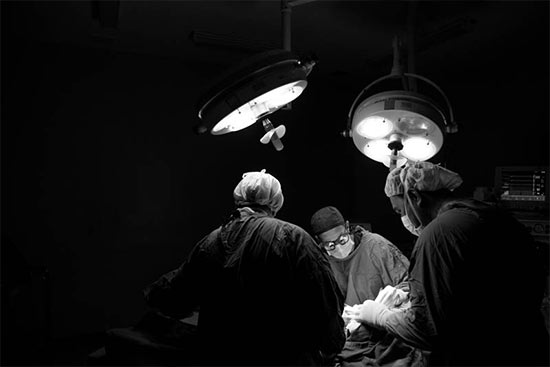Eyelid Lift (Blepharoplasty)
Removes skin from the eyelids and can change the shape of the eye
What is a blepharoplasty?
As we age, many people develop loose skin on their upper eyelids that can start to rest on the eyelashes, giving a feeling of heaviness, or even cause partial obstruction of vision. This can occur earlier and more noticeably in people with a normally low eyebrow position, or with a family history of similar concerns because of their inherited facial anatomy.
The lower eyelids can also start to descend and change shape as a result of the effects of ageing and general loss of elasticity of the supporting structures of the eyelids.
Eye lift surgery (blepharoplasty) is designed to remove the excess skin, and to tighten the support structure of the eyelids. This procedure can occasionally be medically indicated if the excess skin on the upper eyelid is significant enough to obscure your vision.
What are the benefits of this procedure?
Removing excess and heavy skin from the upper eyelids can remove the feeling of heaviness and make the eyes feel more widely open. It can also remove the physical cause of a restriction in the visual field. Although a relatively simple procedure, it can nonetheless create a significant change in symptoms.
Is Mr Morgan experienced in this procedure?
As a specialist plastic surgeon with a special interest in facial surgery, Mr Morgan has performed this type of surgery many times and is comfortable operating around the intricate anatomy of the eyelids. He will be able to show photos of his other patients who have undergone this procedure to give a sense of what change can be achieved. These results are specific to these patients, and may not accurately reflect the types of result you may achieve. All results can vary for a number of reasons, including differences in genetics and original appearance, as well as differences in healing and recovery. Despite all care being taken, complications can and do occur, and can also affect the final result. Occasionally, revisional surgery is required.


How is it performed?
The surgery can be performed under local anaesthetic, but is most commonly performed under general anaesthesia. It is usually performed as day surgery, especially if surgery is performed on the upper eyelids only. Procedures on all four eyelids may entail an overnight stay in hospital.
Upper eyelids have the excess skin removed, as well as any prominent fat. Lower eyelid surgery repositions fat in the area, and tightens and repositions the support structures of the eyelid. The scars are designed to be camouflaged in existing crease lines and can be difficult to see when healed.
Swellings and bruising has usually settled within two weeks, but some may experience excessive bruising that lasts for a few weeks.

How long will I need to recover?
Your first post-operative appointment will occur between 7-10 days later and will involve removal of sutures from the wounds. Dressings are minimal during this time due to the location of the wounds on the eyelids.
Bruising and swelling has generally dissipated by two weeks, and any discomfort after the surgery should also have settled by this time.
Generally, most patients will have recovered sufficiently in two weeks to return to social activity and office-based work. More physical activity will require extra time. Exercise is generally allowed to commence from 4 weeks, with unrestricted activity allowed from 6 weeks. Full recovery from the surgery, and maturation of the scars, can take several months.
Specific Risks and Complications
Eye lift surgery (blepharoplasty) has several potential specific risks:
- Excessive bruising and swelling, visible scarring, wound infections, bleeding behind the eye (potentially causing loss of vision, or blindness), excess skin removal (causing issues with eye protection), asymmetry, dissatisfaction with cosmetic result, need for revisional surgery, eye injury, blindness in one or both eyes (reflex sympathetic ophthalmia – rare)
- This is not an exhaustive list of potential risks. Every patient responds differently to surgery and anaesthesia, and can heal and recover differently. Individual results can vary. The results experienced by one patient do not always reflect the results other patients may achieve. Potential outcomes and possible variations will be discussed during your consultations
All Surgical Procedures Carry Risks
Before proceeding, you should seek a second opinion from an appropriately qualified medical practitioner.
Individual results may vary due to a number of factors, including genetics, and variations in healing and recovery, and the potential for complications. The outcomes experienced by one person do not necessarily reflect the outcomes that other people may experience. Potential outcomes and possible variations will be discussed during your consultations
Cosmetic surgery is real surgery, and will most often require a general anaesthetic. All surgery will require a period of recovery before returning to normal activity, as outlined in the particular procedure information. Although uncommon, complications can and do occur, and may affect the final result of your surgery. The potential risks will be discussed fully during your consultations, and you will have the opportunity to ask questions about the various risks in your particular circumstances. Risks may include the general risks of surgery, as well as the risks specific to the procedure, and include poor quality scarring, excessive bruising and swelling, infection, bleeding, pain, asymmetry, nerve injury, anaesthetic complications, drug reactions, unsatisfactory cosmetic outcomes, the need for further surgery, and permanent disability and death.
As a specialist plastic surgeon, Mr Morgan is appropriately trained and qualified to deal with complications of surgery, including the ability to admit you to hospital, if required.
Who should/should not consider this type of surgery?
The best results are achieved in those with a clearly defined concern and realistic expectations about what surgery can achieve. In situations where this is not the case, the outcome from surgery may often be disappointing.
You should not consider this type of surgery as a response to a personal or professional crisis, or under the encouragement of somebody else. Any decision to undergo surgery needs to be for the right reasons. All surgery entails an element of risk, and you should not make any decision regarding surgery at a time of stress.
